Overview
RSPB Snettisham is an extensive reserve situated in the southeast corner of The Wash.
It is well known for its huge numbers of waders – best seen at high spring tides through the autumn and winter – and as a winter roosting site for thousands of pink footed geese. The part of the reserve that is open to the public centres around a series of former gravel pits just inland from the outer sea defence wall. By far the largest part of the reserve is on the mudflats of the Wash that provide the feeding grounds that attract the huge number of waders, especially in the autumn and winter. This is not an accessible part of the reserve, but excellent views over them can be had from the reserve paths.
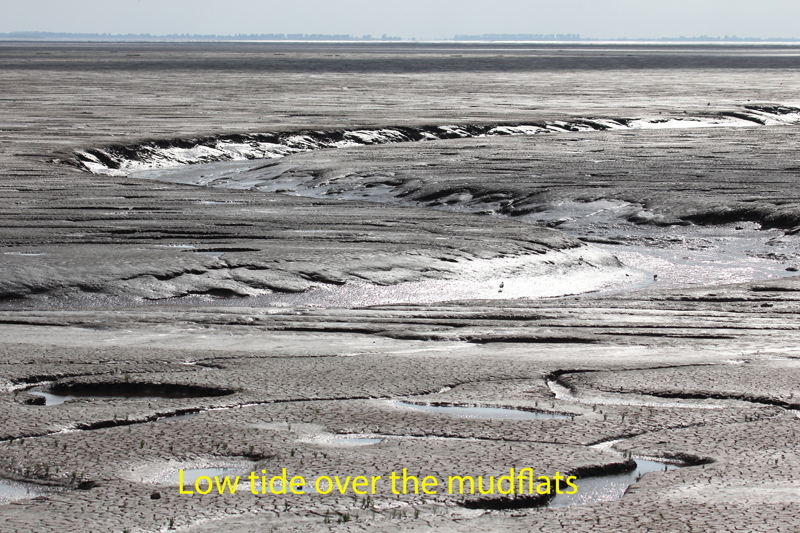
Location
The main access to the reserve is near the seaward end of Beach Road, Snettisham. Heading westwards, towards the sea, the reserve is signposted off to the left as the road makes a right-angle bend to the right. There is a height restriction barrier at 2.1 metres, with limited free parking just outside it. The path to the hides is not wheelchair accessible for its whole length, due to the need to cross a sea wall – part of the local sea defences. But the first part of that path certainly is wheelchair accessible, and has birdwatching possibilities. A permit system controls access by car to a spot near to the first (Rotary) hide. See ‘Parking’ below.
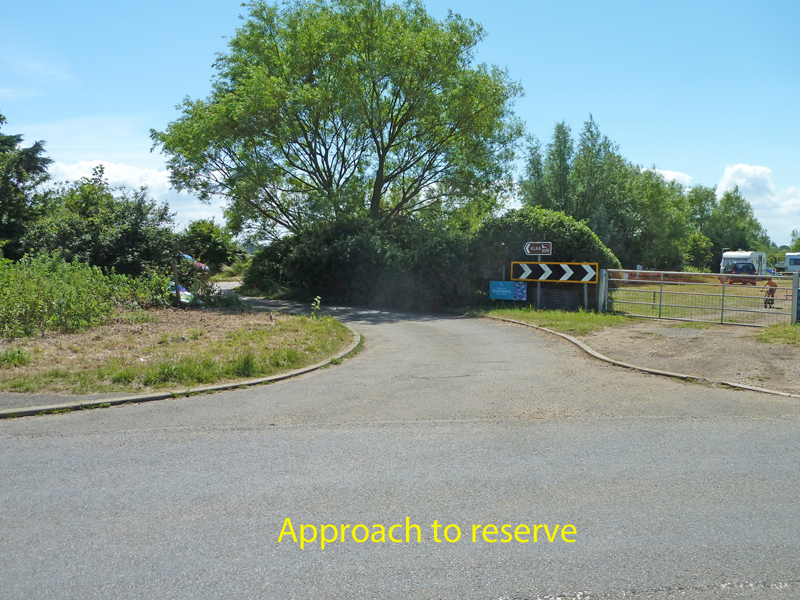
Map reference: TF650328
Google Map: RSPB Snettisham
Public Transport links: The reserve is not easily accessible by public transport. The nearest railway station is at Kings Lynn (12 miles). Buses run from King’s Lynn bus station (several hundred metres from the railway station) to Hunstanton, via Snettisham. Two companies run services – Stagecoach Norfolk (www.stagecoachbus.com), and Linx buses (www.linxbus.co.uk). Or call Traveline East Anglia on 0871 2002 233. Note these services go through the centre of Snettisham, approximately 5 kms from the reserve. There is no bus service closer to the reserve. There is shelter but no seating at the Snettisham bus stop. Buses can accommodate one wheelchair (but always check in advance).
Accessible taxis include Steve’s Taxi Service, tel: 01485 540019
Car parking: A free car park with space for 80 cars is situated approximately 1 mile (1.6km) from the first hide. 2020 a vehicle charge was introduced at Snettisham for non-members, this is currently £3 per vehicle to park all day. Blue Badge holders can apply for a permit to the special access parking point at no charge. Non blue badge holders requiring mobility assistance can request a permit but will be asked to pay for parking.
As always, parking remains free for all RSPB member vehicles.
(See above, under ‘Location’, for directions to this car park).
Car park surface is loose gravel, but well consolidated.
There is a height restriction barrier of 2.1 m, and some limited free parking available outside the barrier. Minibuses would probably have to park outside the barrier.
There is no lighting.
There are no bays designated for disabled drivers in the main car park but visitors with limited mobility may drive to within 100m of the first hide along a rough, gated track. This has a different access point. Please contact the warden at least five working days before your visit to obtain an access permit. Please note that due to very limited space by the gate it is not practicable for unaccompanied wheelchair users to open and close this gate. An assistant would be needed. Birding for All was asked to examine this access during the survey, to see if a different solution could be found. Other technical solutions were considered, but none were viable, and the best recommendation was to try and clear back the vegetation on the reserve side of the gate, and also improve the gate latching system. These measures are still under consideration by the RSPB.

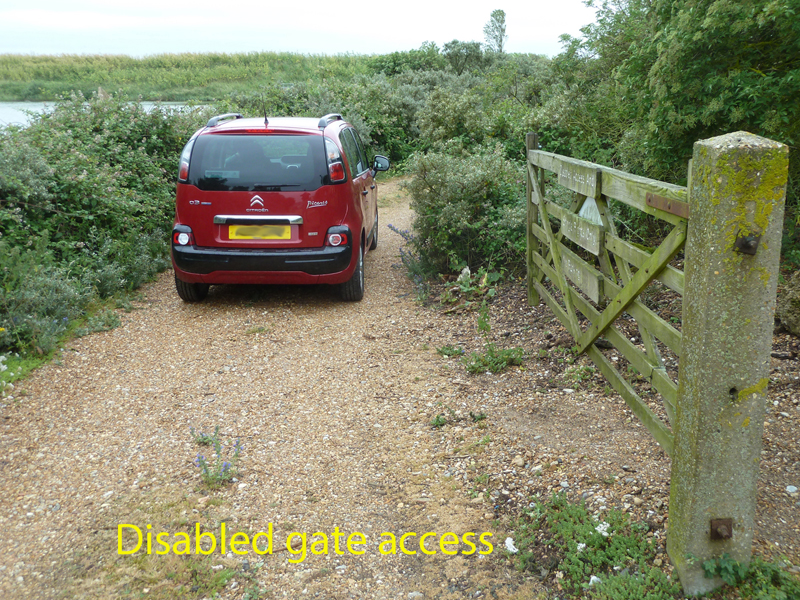
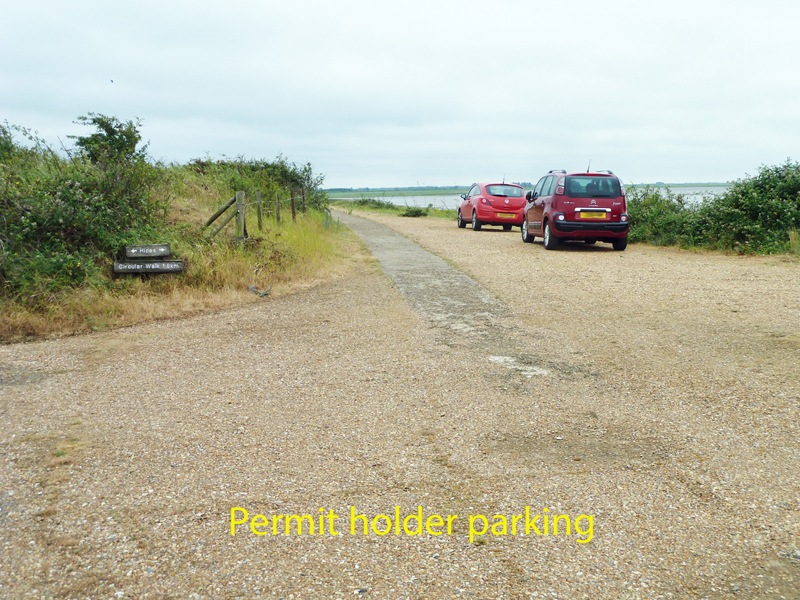
Opening hours: The reserve is open at all times
Contact details: There is no RSPB office at the reserve, though a warden or volunteer is often on site, especially at high spring tides. The warden can be contacted as follows:
Email: snettisham@rspb.org.uk
Tel: 01485 210779
Toilets: There are no toilets on site.
Telephone: There is no telephone on site. Please note that mobile phone signals here can be very weak, and should not be relied on.
Visitor centre: There is no visitor centre on site.
Leaflets: A free general leaflet, with map, is available for the reserve. There is a dispenser by the display sign in the main car park. At busy times this can run out of leaflets. A more reliable way of getting a leaflet is to call in at the RSPB shop at Titchwell Marsh reserve, further round the coast.
Information on disabled access: There is a statement on the reserve website, though it has less detailed information than this report.
Assistance dogs: These are certainly allowed. The RSPB website has this about dogs in general:
“Dogs are welcome under close control. We encourage responsible dog walking, and ask you to keep your dog on a lead while you are on the reserve. This is particularly important between mid-April and mid-August, when ringed plovers and oystercatchers nest on the beach, and on the highest tides when flocks of wading birds may roost on the beach.” The photo of an oystercatcher and chick was taken (from a non-intrusive distance) on one of the survey days.

Trails & Paths
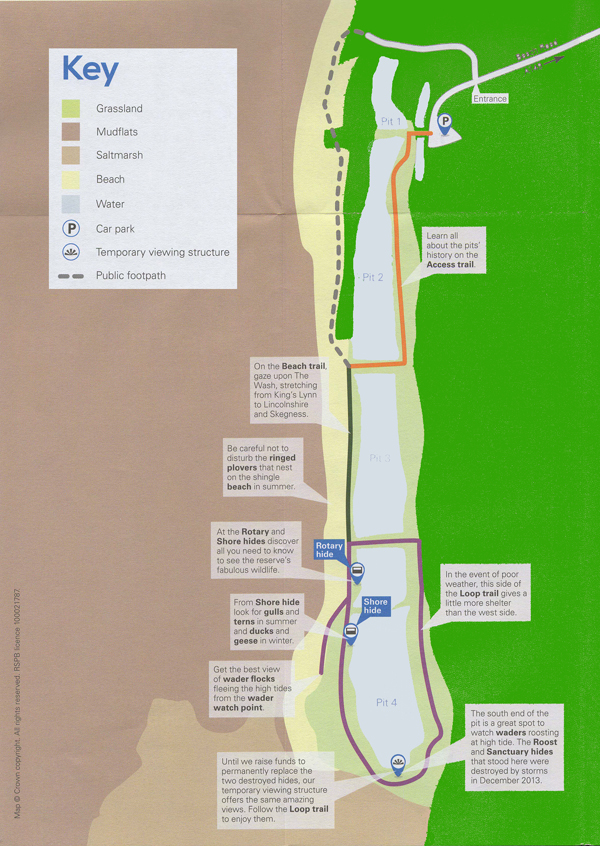
There are three sections of trail, identified on the reserve map as the Access Trail, the Beach Trail and the Loop Trail.
Access Trail
This trail leads from the car park and connects with the Beach Trail as it reaches the outer sea wall. It takes about 15 minutes to walk, not allowing for birdwatching stops or rests. Total distance is about 1.3 kms.
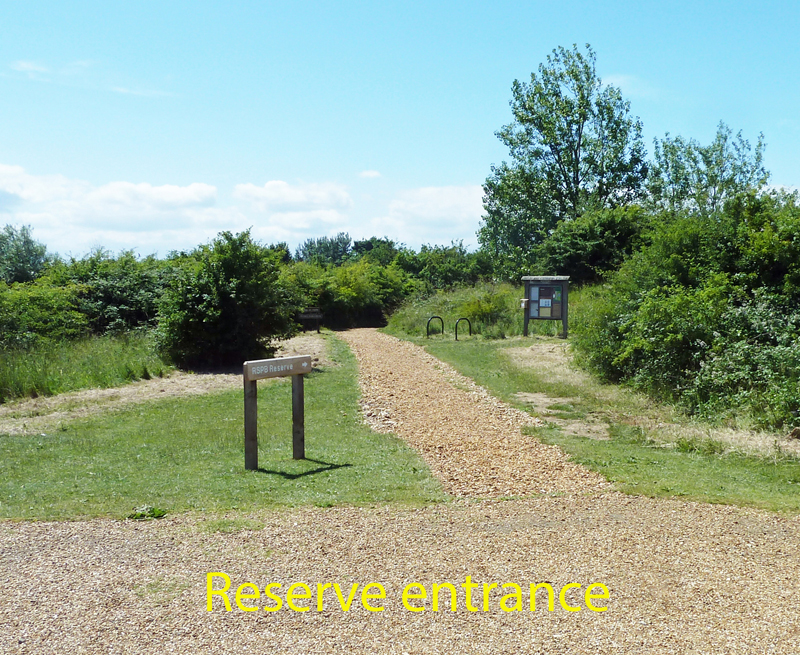
If you have not visited the reserve recently you are in for a pleasant surprise. In 2016 the Access Trail was widened and resurfaced with rolled sand and gravel to a high specification – a significant improvement on the old narrow, and at times muddy, path. Most of the path is at least a metre wide, with no obstructions from overhanging vegetation. It is mostly level, with two short stretches near the car park with gradients of about 1 in 11.
The Access Trail has to cross one flood bank, and rise up to another, so there are three sets of steps to negotiate in all. It is for this reason that the path is not wheelchair accessible for its whole length. It is, however, fully accessible to wheelchair users up to the first flight of steps (a distance of about c 250 metres), and this section can give good birdwatching opportunities – especially of warblers in the bushes. There is plenty of room for wheelchairs to pass. Counting from the car park, the first set of steps consists of 19 steps, of width 140 cms. Each step is about 48 cms deep, with a rise of 10-20 cms per step. There are wooden handrails on each side at a height of about 100cms.
The flight of steps down from the flood bank has 15 steps of similar dimensions.
The third and final flight of steps has 20 steps, each 10-15cms high, about 50 cms deep and 130 cms wide. It too has handrails each side, at a height of about 95 cms.
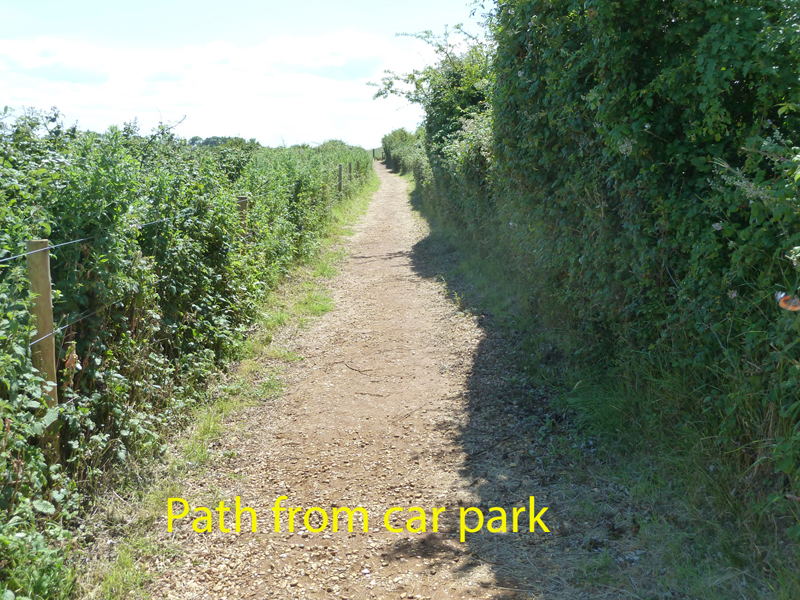

Currently there are no benches or perches on the first section of path. Between the two sets of steps there are currently three resting places. Two of these are tripod-style perches with a low back, each with room for one person. They were partly overgrown on the survey day, so not very accessible, but the vegetation had been trimmed back by a later visit. Neither offers views other than of the path. There is also a very solid backless bench with room for several people (180 cms wide). The seat is 63 cms high and 30 cms deep. It offers good views over the nearby lagoon (Pit 2). During the survey Birding For All was asked to comment on seat provision on the reserve, and identified some possible sites for extra seats. The RSPB is currently considering the possibility of adding more seating to this stretch of path.


Beach Trail
This trail leads along the sea wall from the end of the Access Trail to where it joins the Loop Trail – a distance of about 600 metres. This path has a surface that is either well-consolidated gravel, or concrete. The permit-only route for drivers enters the reserve at the northern end of this trail, and permit holders can drive along the Beach Trail to a point just south of the junction with the Loop Trail.
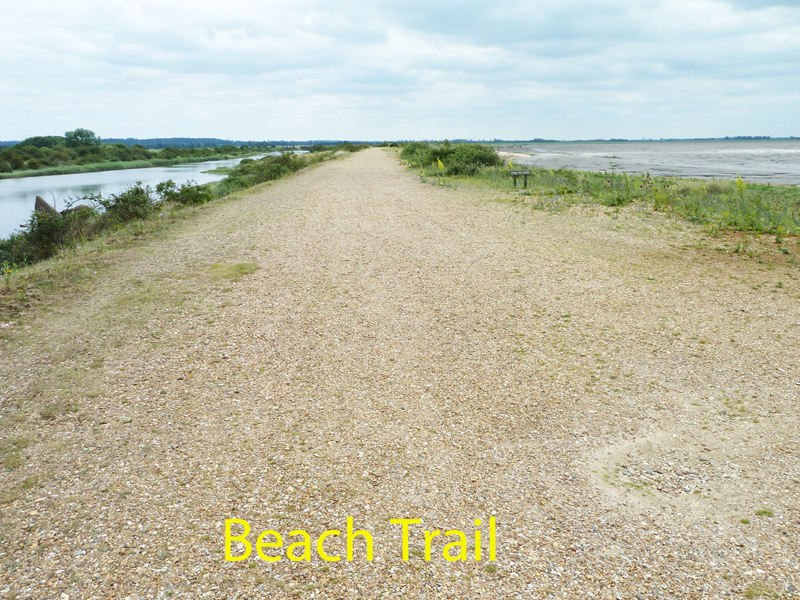
The Beach Trail is wide and level, with no obstructions of any kind, but there are fairly steep drops to both sides, with no barrier fencing.
There are three garden bench type seats, with backrests and arms, at the point where this trail meets the Loop Trail. At 180 cms wide each these seats can accommodate more than a few people.
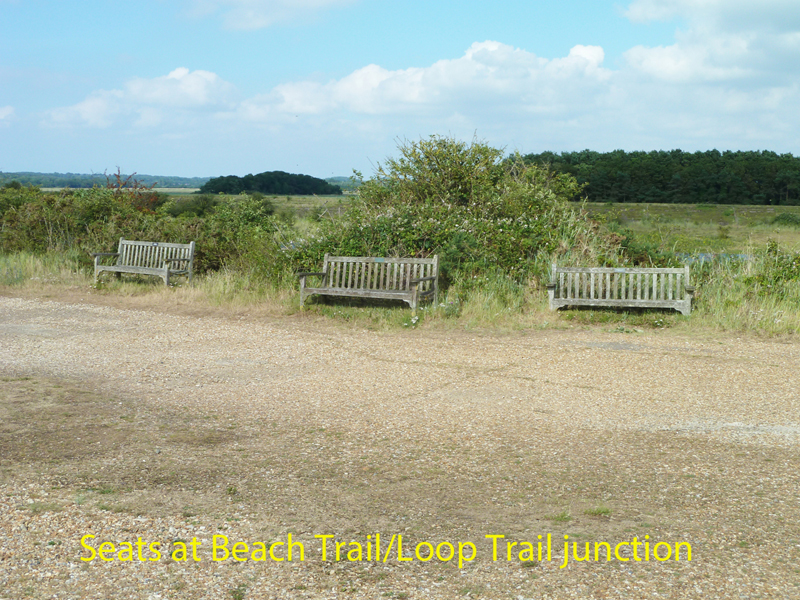
Loop Trail
This trail is a circular trail around the perimeter of the southernmost gravel pit – Pit 4. In total it measures just under 2 kms, but only about half of it is wheelchair accessible – from the southern end of the Beach Trail past Rotary and Shore Hides as far as the temporary Roost Hide at the southern end of the pit (but see photo and note below about gradients). There is a section of trail that branches off to get to the Wader Watch Point – a distance of about 150 metres.
Starting at the junction with the Beach Trail the surface is mostly concrete. This is in good condition. The concrete continues as far as Shore Hide. Between the two hides is a backless bench, with excellent views over the sea/mudflats.
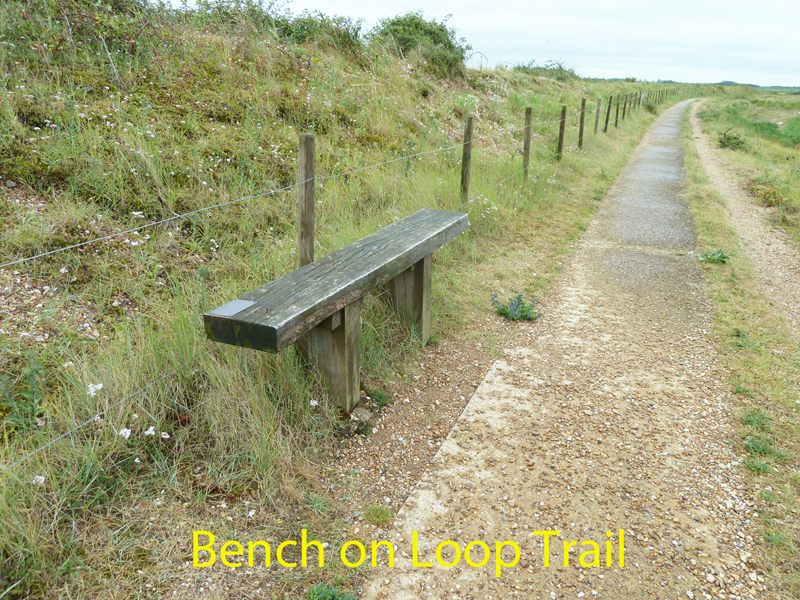
The branch to the Wader Watch Point has vegetation growing over this concrete, but it is firm and smooth, and wheelchair accessible. There are two garden-style benches at the watch point.
South of Shore Hide the path mostly consists of consolidated sand and gravel, being replaced after about 430 metres by board walk, just after the path turns north towards the temporary Roost Hide. Part of the sand and gravel section can be flooded at very high spring tides, and also has puddles after heavy rain. On the board walk the boards are covered with wire for grip, but there are no side upstands. Just before you get to Roost Hide the path rises up to cross a flood bank. While the board walk is even and wide, with netting for grip, the gradient of nearly 1 in 7 will be a challenge for solo wheelchair users.
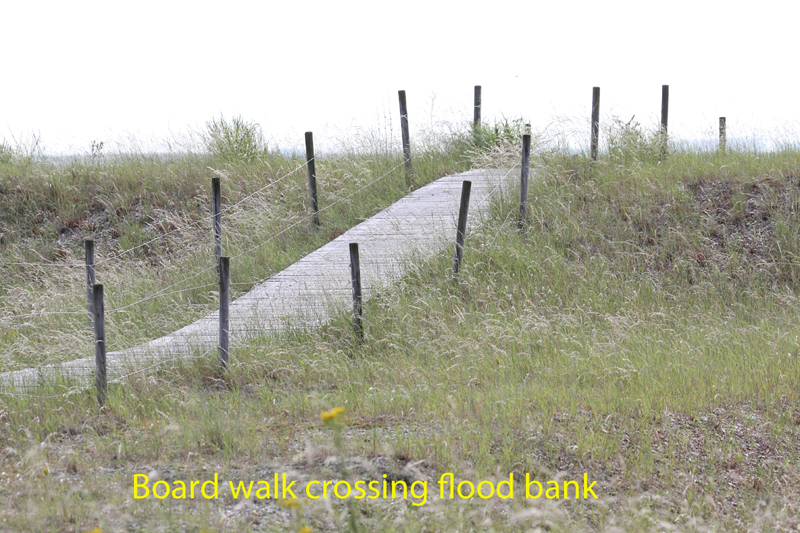
The board walk extends some 220 metres. At the end of the board walk the path narrows, becomes loose gravel with varying amounts of vegetation, and is not wheelchair accessible. This section extends up the east bank (inland) side of Pit 4, until it reaches a causeway that allows you to cross over the pit and back to the southern end of the Beach Trail. The causeway was washed away in a storm surge in December 2013 and had to be replaced. It consists of loose gravel, which is gradually becoming more consolidated and vegetated.
The path that is wheelchair-accessible is wide and unobstructed, with room for passing in most places. The path along the eastern side of Pit 4 is narrow and uneven in places, with some stretches of loose gravel and close-growing bushes.
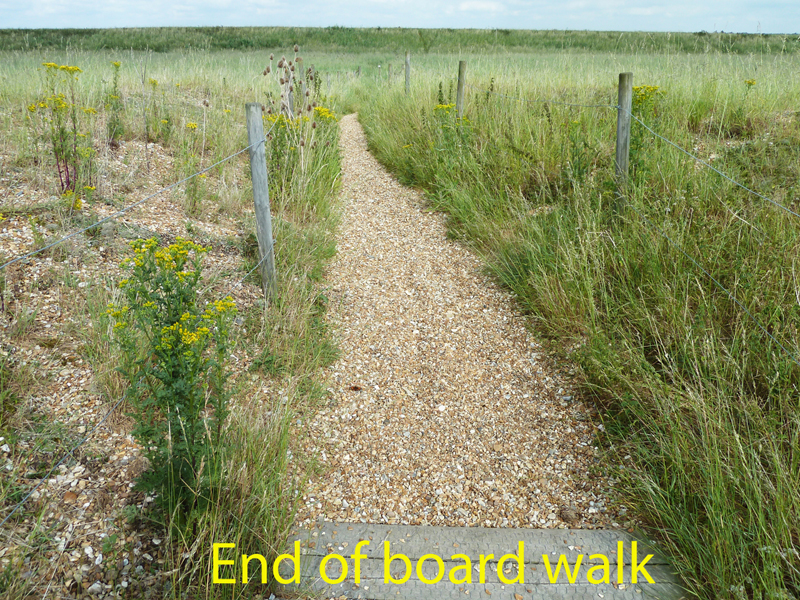
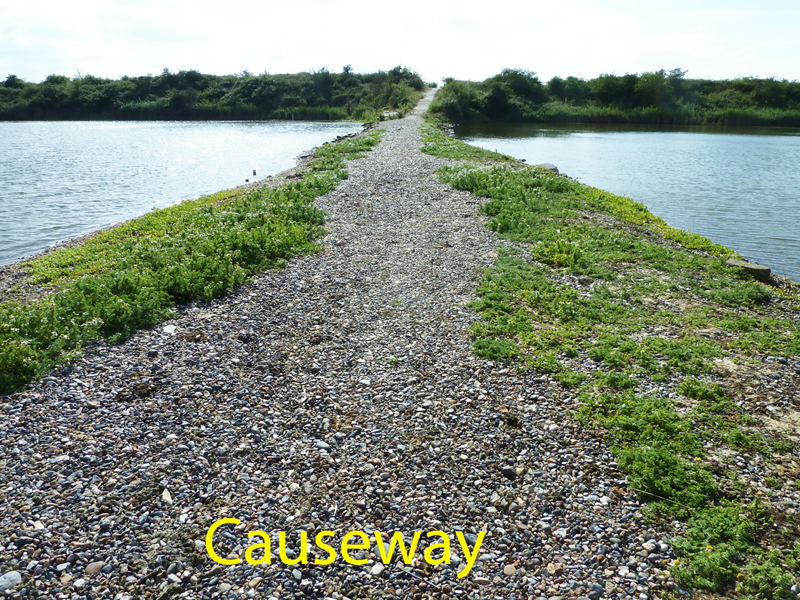
Hides
Rotary Hide
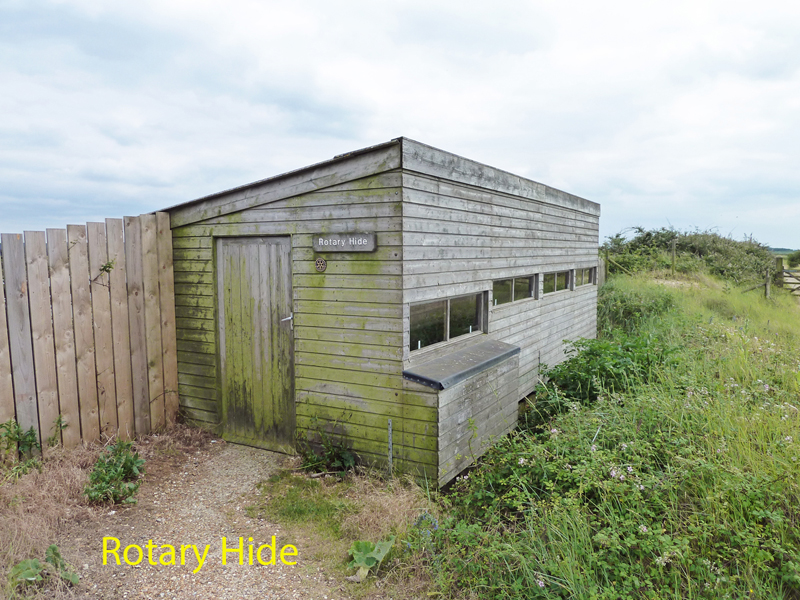
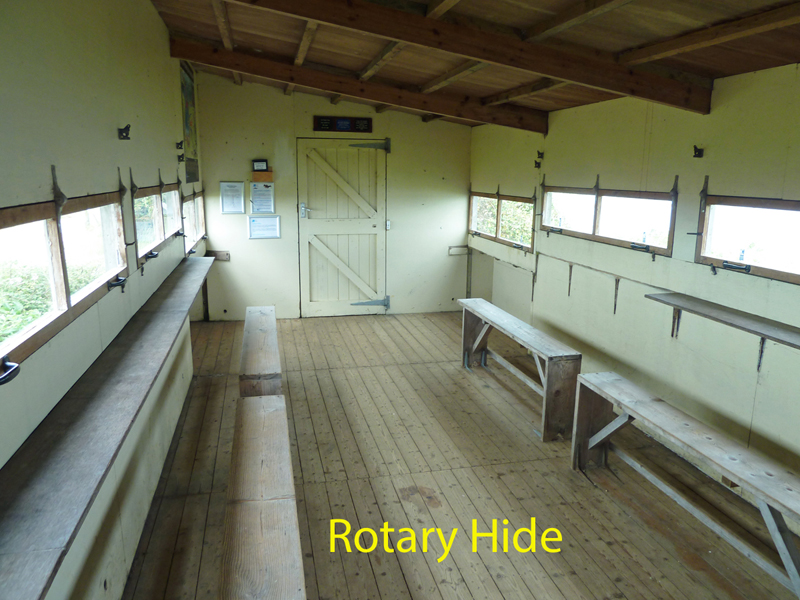
The concrete path to the hide from the permit holder car parking spaces is wheelchair accessible, with room to manoeuvre outside the hide. The door opens inwards, and there is no threshold step. The opening is 85cms wide, and the lever door handles are at 122 cms. Inside the hide is quite spacious. So access to the hide for wheelchair users is good, but some aspects of the hide interior do not provide the best experience for them. There is a wheelchair bay just inside the door on the left. There is a knee space. It is 74 cms high, but very shallow, at only 34 cms, which would prevent most wheelchairs users from getting as close to the viewing slot as they would like. There is no shelf below the viewing slot, so nowhere to rest your elbows when using binoculars. The glazed flap is 170 cms wide, and on the heavy side. Good large ‘D’ handles are provided, but the gate-style latches are 165 cms off the floor, which means they are inaccessible to some wheelchair users. On the positive side the viewing slot is 46cms high, with its lower edge just 90 cms off the floor, affording good views out over the lagoon (if you can get close enough!).
The rest of the viewing slots have fixed bench seating, but there are some gaps for easy access. The shelf at the non-wheelchair bays is 94 cms of the floor, 22 cms deep and 19cms below the opening, which are 36 cms high. The latches here are 172 cms off the floor. Unusually this hide has windows and views on opposing sides – so views can be had out to the Wash and inland over the lagoon.
Shore Hide
Whilst Snettisham Reserve can provide good birding at any time, it is best known for its high tide wader roosts, especially in autumn and winter.


At those times some birders like to stay outside near the Wader Watch Point, to see the waders being pushed in as the tide advances over the mudflats, while others like to be in the hides, watching the flocks of waders descend onto the gravel banks in and beside the lagoon. Yet others like to hedge their bets – staying outside for a while and then moving to a hide as the mudflats get more covered. Such a strategy may pose problems for wheelchair users, as the Rotary and Temporary Roost Hides can get very crowded. It has been known for queues to form outside the Roost Hide as it is so full. Wheelchair users may wish to consider this in deciding where they want to be. The RSPB hopes to alleviate this situation by providing better viewing facilities in the near future, but this is dependent on the availability of funding. See the note about this under Roost Hide.
The RSPB publishes “Birdwatchers’ tide tables” for the area, with colour coding to denote the best tides for seeing the wader displays. Please note that it is worth arriving well before estimated high tide time – at least an hour – in order to see much of the activity. If you have mobility issues, then you would need to factor that in. The permit-holder only driving route is along a very uneven track.
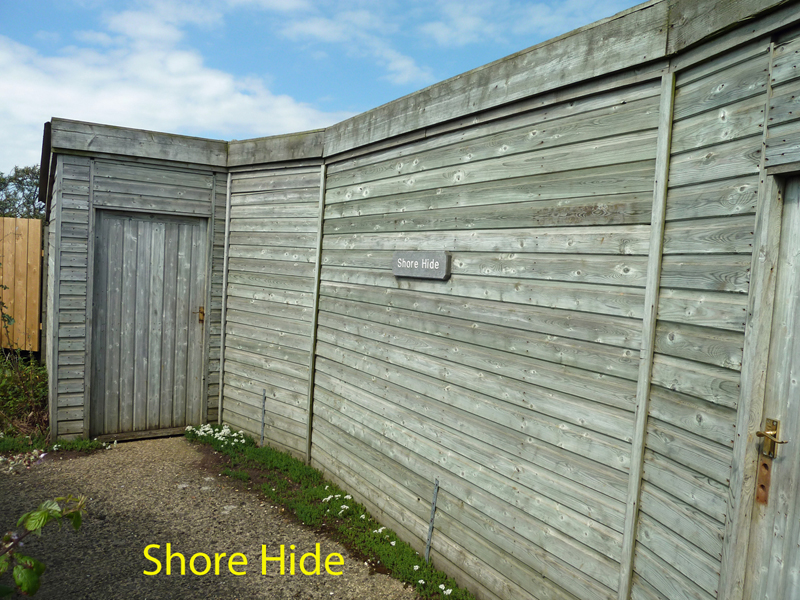

The concrete path leading to Shore Hide from Rotary Hide is wheelchair accessible. It is mostly level, with a gentle downslope as you approach the hide. There is plenty of room to manoeuvre outside the hide, which has two doors, both 86 cms wide. Lever handles are provided at 112 cms high on the first door and 124 cms high on the second. Both doors open inwards, and there are no threshold steps.
Provision for wheelchair users inside the hide is somewhat better than at the Rotary Hide, with a 3.5 metre-wide bay that can accommodate several wheelchairs. The 75cm high knee space has a decent depth of 70 cms, allowing wheelchair users to get close to the viewing slot. However, once again there is no shelf below the 38cms-high slot, and at this hide the bottom edge of the slot is 96 cms high. This makes it difficult to look out from the hide to birds that are in close. This is particularly an issue here as the Rotary Hide is elevated above the lagoon, and there is an island close in, with nesting birds in season and waders at all times.
There are three flaps closing the slots over the wheelchair bay – each 116cnms wide. The flaps are reasonably light and have good ‘D’ handles, but the gate-style latches are about 167cms off the floor which means they are inaccessible to some wheelchair users.
For other users, there is fixed bench seating at all the other viewing slots, with gaps at the wheelchair bay end to allow easy access. There are three lightweight plastic chairs with backs, which usually reside in the wheelchair bays, but can be easily moved if required.
Roost Hide
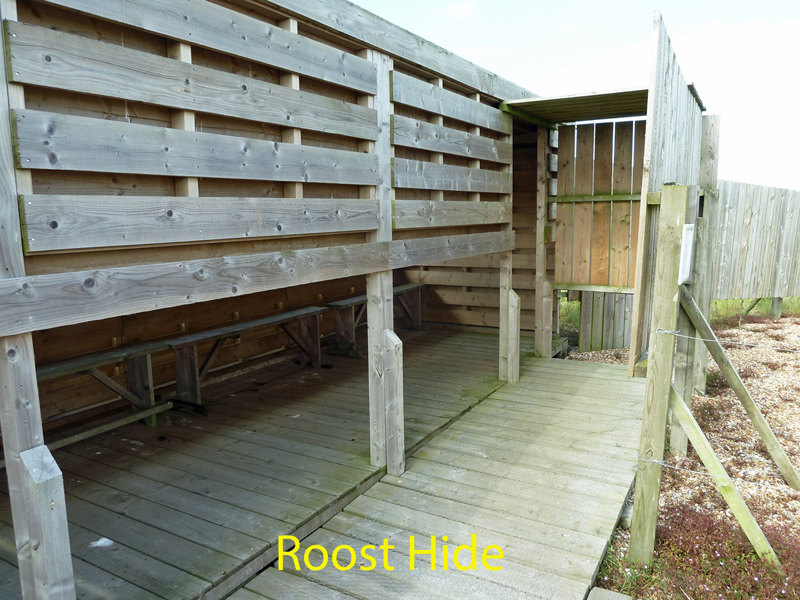
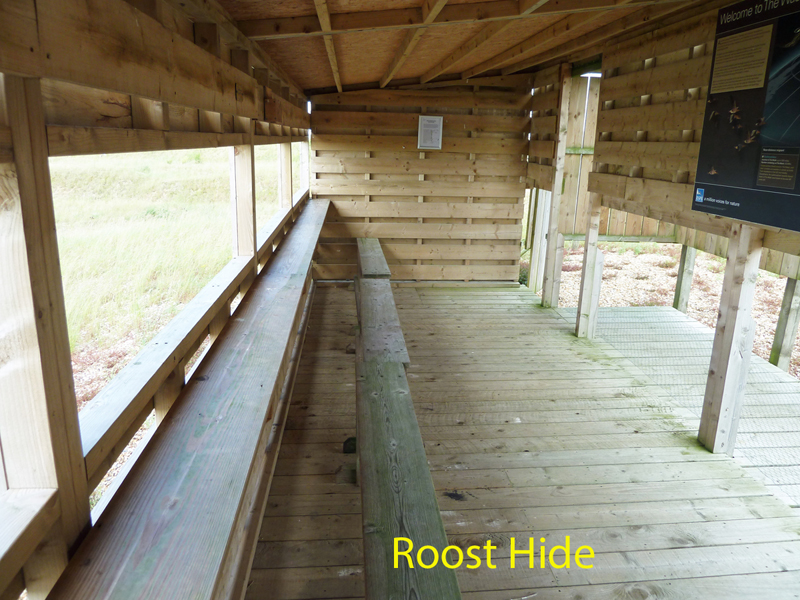
The path to Roost Hide from Rotary Hide consists of consolidated sand and gravel until the board walk section is reached. This can have puddles after heavy rain, and a short section does flood at very high spring tides – and there is no easy bypass for wheelchair users. The ramp over the flood bank may prove an issue for solo wheelchair users, but can be accessed by those with assistance.
The current Roost Hide building is a temporary structure, erected after the previous hide was destroyed in a storm surge in 2013. It has no door and no threshold, with an opening of 82 cms. So wheelchairs can get in. There is, however, no dedicated wheelchair bay with knee space, and the viewing slots are 106cms off the floor. This makes it difficult for wheelchair users to see birds that may be close in. There are no flaps, and the slots are 46cms high.
The RSPB is fully aware that facilities at this hide are less than perfect, but at least they have provided temporary facilities while longer-term solutions can be found. A new ‘state of the art’ building has now been designed, and will be built when funding allows. A crowd-funding appeal was launched in summer 2017 which brought in some funds, and successful applications to charitable trusts, together with continued individual donations, have added more money, but there is some way still to go before the target is reached.
Pink-footed goose roost
Snettisham reserve is also well-known as an internationally important roosting site for pink-footed geese. They often take off from the mudflats at dawn in huge numbers, heading for feeding grounds inland. Permit holders may drive onto the reserve as described above, but please note that the geese are easily disturbed by lights. If your car has running lights that cannot be switched off then you must wait until after dawn before entering the reserve. Full details are given on the access permit.
